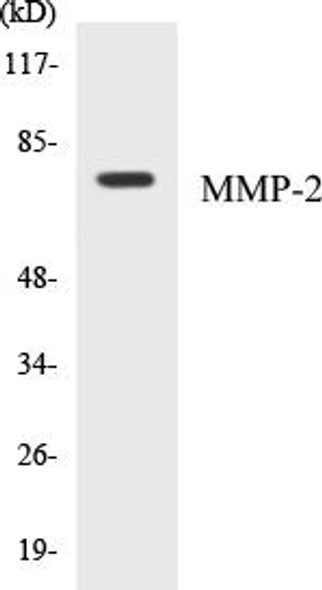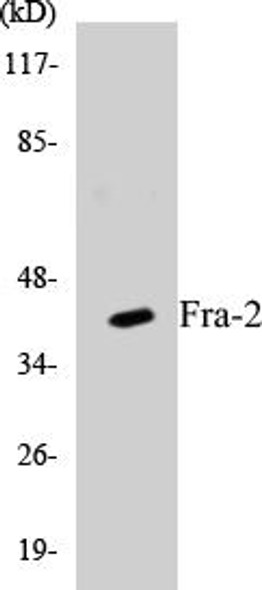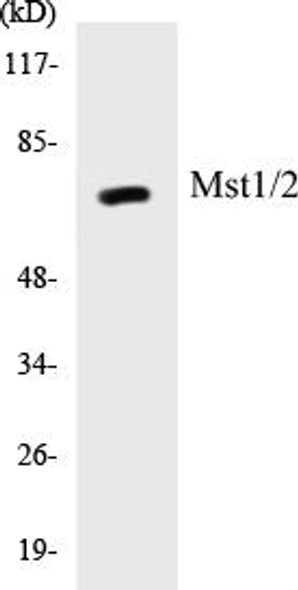Neuroscience
GAD1/2 Colorimetric Cell-Based ELISA Kit
- SKU:
- CBCAB00668
- Product Type:
- ELISA Kit
- ELISA Type:
- Cell Based
- Research Area:
- Neuroscience
- Reactivity:
- Human
- Reactivity:
- Mouse
- Detection Method:
- Colorimetric
Description
| Product Name: | GAD1/2 Colorimetric Cell-Based ELISA |
| Product Code: | CBCAB00668 |
| ELISA Type: | Cell-Based |
| Target: | GAD1/2 |
| Reactivity: | Human, Mouse |
| Dynamic Range: | > 5000 Cells |
| Detection Method: | Colorimetric 450 nmStorage/Stability:4°C/6 Months |
| Format: | 96-Well Microplate |
The GAD1/2 Colorimetric Cell-Based ELISA Kit is a convenient, lysate-free, high throughput and sensitive assay kit that can detect GAD1/2 protein expression profile in cells. The kit can be used for measuring the relative amounts of GAD1/2 in cultured cells as well as screening for the effects that various treatments, inhibitors (ie siRNA or chemicals), or activators have on GAD1/2.
Qualitative determination of GAD1/2 concentration is achieved by an indirect ELISA format. In essence, GAD1/2 is captured by GAD1/2-specific primary antibodies while the HRP-conjugated secondary antibodies bind the Fc region of the primary antibody. Through this binding, the HRP enzyme conjugated to the secondary antibody can catalyze a colorimetric reaction upon substrate addition. Due to the qualitative nature of the Cell-Based ELISA, multiple normalization methods are needed:
| 1. | A monoclonal antibody specific for human GAPDH is included to serve as an internal positive control in normalizing the target absorbance values. |
| 2. | Following the colorimetric measurement of HRP activity via substrate addition, the Crystal Violet whole-cell staining method may be used to determine cell density. After staining, the results can be analysed by normalizing the absorbance values to cell amounts, by which the plating difference can be adjusted. |
| Database Information: | Gene ID: 2571/2572, UniProt ID: Q99259/Q05329, OMIM: 605363/138275, Unigene: Hs.420036/Hs.231829 |
| Gene Symbol: | GAD1/GAD2 |
| Sub Type: | None |
| UniProt Protein Function: | GAD67: Catalyzes the production of GABA. Homodimer. Isoform 3 is expressed in pancreatic islets, testis, adrenal cortex, and perhaps other endocrine tissues, but not in brain. Belongs to the group II decarboxylase family. 3 isoforms of the human protein are produced by alternative splicing. |
| UniProt Protein Details: | Protein type:EC 4.1.1.15; Other Amino Acids Metabolism - beta-alanine; Other Amino Acids Metabolism - taurine and hypotaurine; Carbohydrate Metabolism - butanoate; Amino Acid Metabolism - alanine, aspartate and glutamate; Mitochondrial; Lyase Chromosomal Location of Human Ortholog: 2q31 Cellular Component: plasma membrane; intracellular; vesicle membrane Molecular Function:protein binding; glutamate binding; glutamate decarboxylase activity; protein heterodimerization activity; protein N-terminus binding; pyridoxal phosphate binding Biological Process: response to drug; glutamate catabolic process; synaptic transmission; glutamate decarboxylation to succinate; neurotransmitter secretion; gamma-aminobutyric acid biosynthetic process; protein-pyridoxal-5-phosphate linkage; neurotransmitter biosynthetic process Disease: Cerebral Palsy, Spastic Quadriplegic, 1 |
| NCBI Summary: | This gene encodes one of several forms of glutamic acid decarboxylase, identified as a major autoantigen in insulin-dependent diabetes. The enzyme encoded is responsible for catalyzing the production of gamma-aminobutyric acid from L-glutamic acid. A pathogenic role for this enzyme has been identified in the human pancreas since it has been identified as an autoantigen and an autoreactive T cell target in insulin-dependent diabetes. This gene may also play a role in the stiff man syndrome. Deficiency in this enzyme has been shown to lead to pyridoxine dependency with seizures. Alternative splicing of this gene results in two products, the predominant 67-kD form and a less-frequent 25-kD form. [provided by RefSeq, Jul 2008] |
| UniProt Code: | Q99259 |
| NCBI GenInfo Identifier: | 1352213 |
| NCBI Gene ID: | 2571 |
| NCBI Accession: | Q99259.1 |
| UniProt Secondary Accession: | Q99259,Q49AK1, Q53TQ7, Q9BU91, Q9UHH4, |
| UniProt Related Accession: | Q99259 |
| Molecular Weight: | 66,897 Da |
| NCBI Full Name: | Glutamate decarboxylase 1 |
| NCBI Synonym Full Names: | glutamate decarboxylase 1 (brain, 67kDa) |
| NCBI Official Symbol: | GAD1 |
| NCBI Official Synonym Symbols: | GAD; SCP; CPSQ1 |
| NCBI Protein Information: | glutamate decarboxylase 1; GAD-67; 67 kDa glutamic acid decarboxylase; glutamate decarboxylase 67 kDa isoform |
| UniProt Protein Name: | Glutamate decarboxylase 1 |
| UniProt Synonym Protein Names: | 67 kDa glutamic acid decarboxylase; GAD-67; Glutamate decarboxylase 67 kDa isoform |
| Protein Family: | Glutamate decarboxylase |
| UniProt Gene Name: | GAD1 |
| UniProt Entry Name: | DCE1_HUMAN |
| Component | Quantity |
| 96-Well Cell Culture Clear-Bottom Microplate | 2 plates |
| 10X TBS | 24 mL |
| Quenching Buffer | 24 mL |
| Blocking Buffer | 50 mL |
| 15X Wash Buffer | 50 mL |
| Primary Antibody Diluent | 12 mL |
| 100x Anti-Phospho Target Antibody | 60 µL |
| 100x Anti-Target Antibody | 60 µL |
| Anti-GAPDH Antibody | 60 µL |
| HRP-Conjugated Anti-Rabbit IgG Antibody | 12 mL |
| HRP-Conjugated Anti-Mouse IgG Antibody | 12 mL |
| SDS Solution | 12 mL |
| Stop Solution | 24 mL |
| Ready-to-Use Substrate | 12 mL |
| Crystal Violet Solution | 12 mL |
| Adhesive Plate Seals | 2 seals |
The following materials and/or equipment are NOT provided in this kit but are necessary to successfully conduct the experiment:
- Microplate reader able to measure absorbance at 450 nm and/or 595 nm for Crystal Violet Cell Staining (Optional)
- Micropipettes with capability of measuring volumes ranging from 1 µL to 1 ml
- 37% formaldehyde (Sigma Cat# F-8775) or formaldehyde from other sources
- Squirt bottle, manifold dispenser, multichannel pipette reservoir or automated microplate washer
- Graph paper or computer software capable of generating or displaying logarithmic functions
- Absorbent papers or vacuum aspirator
- Test tubes or microfuge tubes capable of storing ≥1 ml
- Poly-L-Lysine (Sigma Cat# P4832 for suspension cells)
- Orbital shaker (optional)
- Deionized or sterile water
*Note: Protocols are specific to each batch/lot. For the correct instructions please follow the protocol included in your kit.
| Step | Procedure |
| 1. | Seed 200 µL of 20,000 adherent cells in culture medium in each well of a 96-well plate. The plates included in the kit are sterile and treated for cell culture. For suspension cells and loosely attached cells, coat the plates with 100 µL of 10 µg/ml Poly-L-Lysine (not included) to each well of a 96-well plate for 30 minutes at 37°C prior to adding cells. |
| 2. | Incubate the cells for overnight at 37°C, 5% CO2. |
| 3. | Treat the cells as desired. |
| 4. | Remove the cell culture medium and rinse with 200 µL of 1x TBS, twice. |
| 5. | Fix the cells by incubating with 100 µL of Fixing Solution for 20 minutes at room temperature. The 4% formaldehyde is used for adherent cells and 8% formaldehyde is used for suspension cells and loosely attached cells. |
| 6. | Remove the Fixing Solution and wash the plate 3 times with 200 µL 1x Wash Buffer for five minutes each time with gentle shaking on the orbital shaker. The plate can be stored at 4°C for a week. |
| 7. | Add 100 µL of Quenching Buffer and incubate for 20 minutes at room temperature. |
| 8. | Wash the plate 3 times with 1x Wash Buffer for 5 minutes each time. |
| 9. | Add 200 µL of Blocking Buffer and incubate for 1 hour at room temperature. |
| 10. | Wash 3 times with 200 µL of 1x Wash Buffer for 5 minutes each time. |
| 11. | Add 50 µL of 1x primary antibodies (Anti-GAD1/2 Antibody and/or Anti-GAPDH Antibody) to the corresponding wells, cover with Parafilm and incubate for 16 hours (overnight) at 4°C. If the target expression is known to be high, incubate for 2 hours at room temperature. |
| 12. | Wash 3 times with 200 µL of 1x Wash Buffer for 5 minutes each time. |
| 13. | Add 50 µL of 1x secondary antibodies (HRP-Conjugated AntiRabbit IgG Antibody or HRP-Conjugated Anti-Mouse IgG Antibody) to corresponding wells and incubate for 1.5 hours at room temperature. |
| 14. | Wash 3 times with 200 µL of 1x Wash Buffer for 5 minutes each time. |
| 15. | Add 50 µL of Ready-to-Use Substrate to each well and incubate for 30 minutes at room temperature in the dark. |
| 16. | Add 50 µL of Stop Solution to each well and read OD at 450 nm immediately using the microplate reader. |
(Additional Crystal Violet staining may be performed if desired – details of this may be found in the kit technical manual.)






